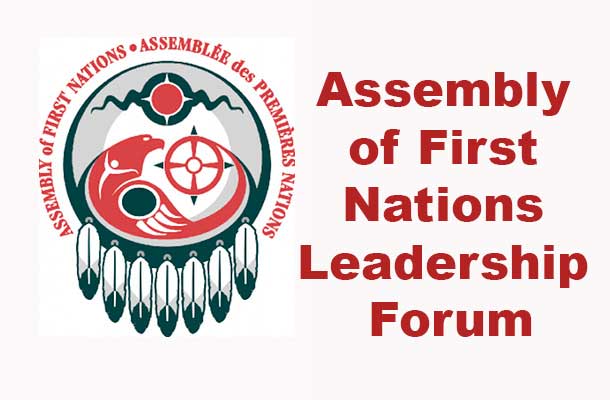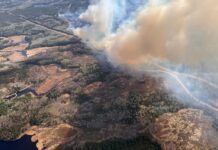OTTAWA – Federal Minister Philpot addressed the Assembly of First Nations meeting in Ottawa on this week.
Here is the text of the Minister’s speech:
Greetings. Kwe. Bonjour.
Thank you, Elder, for your opening drum song and prayer
Acknowledge that we are gathered on traditional Algonquin territory
Acknowledge the National Chief [other Chiefs, other dignitaries…]
I am pleased to be here at this Special Chiefs Assembly as the first minister of Indigenous Services.
I feel privileged to take on my new role, and I am encouraged by the dissolution of INAC and the creation of the Department of Indigenous Services.
This is an important week for many reasons.
On Monday, the government officially created the Department of Indigenous Services Canada, which will include the First Nations and Inuit Health Branch along with other key services – from education, child welfare and early learning to housing and infrastructure. Minister Bennett will continue her consultations on what other pieces could be added to the department prior to legislation being introduced.
The goal of our new department of Indigenous Services is to work in partnership with you and other Indigenous peoples to ensure excellent services, in order to improve the day-to-day quality of life for Indigenous peoples – and in doing so, to close wide socioeconomic gaps that exist between Indigenous and non-Indigenous Canadians.
As we work in partnership with Indigenous peoples to improve services, we do so recognizing – and supporting the implementation of – the right to self-determination. The goal is that, in all sectors, we aim for the design, delivery, and control of services to be led by Indigenous peoples for Indigenous peoples. When that is achieved, there should no longer be a need for our department in the federal government.
I believe this may be the first government department ever created with its eventual obsolescence as an intentional outcome.
In the meantime, we will partner with you to support high-quality services for First Nations.
I want to acknowledge that this is December 6th, the National Day of Remembrance and Action on Violence against Women. Today, we remember 14 women who were killed 28 years ago at École Polytechnique in Montreal.
We think of all women who have been victims of violence in Canada, including Indigenous women who experience higher rates of violence than non-Indigenous women. Trauma comes in different forms – sometimes it’s physical violence. But psychological trauma comes from a multitude of causes – from residential schools to babies being separated from their families. Today we must commit ourselves to the prevention, the recognition, and the healing of trauma in all its forms.
Challenges – Opportunities – Partnerships
I’ve decided to touch on 3 themes in my remarks today – based on some of the issues you have emphasized in the past 3 months. The themes are: Challenges, Opportunities and Partnerships.
Challenges: Child and family services
Let’s start with something about the challenges. I’m only going to pick one issue – the issue of First Nations child and family services – though, as you know; there are challenges in all sectors. Like any challenge, it is best understood when you hear someone’s story.
So permit me to tell you about a woman whom I will call Laura. Laura spent her childhood in foster care. At 16, she gave birth. Because she had been a “child in care,” her baby was apprehended at birth. Laura went on to have two more children as an adult but under a system whereby, once you have one child already apprehended, subsequent babies are automatically taken at birth. Laura visited the First Nations Family Advocate Office for support when she was pregnant with her fourth child. Her simple plea was that she wanted to spend a full day with her baby before it was taken. Her baby was born last month and her baby is gone. He was apprehended. She did not get to spend a day with him. Laura was never given a fair shot at life. She suffered as a child in care and the system set her up to fail.
When referring to Indigenous children in the child welfare system, I’m on the record calling this a humanitarian crisis. I’m not trying to be overly sensational. I believe it is a crisis. Census 2016 data indicate that Indigenous children aged 0 to 14 make up 7.7% of all children. But they represent over 52% of children in foster care in private homes.
In some regions of the country Indigenous children makeup 90% of children in care. This is unacceptable.
I know that this is an issue that is important to you. I would like to acknowledge the role of the Assembly of First Nations and the National Advisory Committee on First Nations Child and Family Services Program Reform. We need to bring all partners together to take action. This is work that the federal government cannot and should not do alone.
That is why I have called an Emergency Meeting on Indigenous Child and Family Services for the New Year with Indigenous leaders, provincial and territorial partners, and child and family services experts.
I also want to acknowledge the good work that many of you have accomplished in this sector – some that goes back decades. For example, in 1980, Splatsin, part of the Shuswap Nation in British Columbia, passed it’s By-law for the Care of Our Indian Children, which outlined the community’s approach to child welfare. Since then, Splatsin has continued to provide culturally oriented child and family services to both on- and off-reserve members.
And in Nova Scotia, the Mi’kmaw have worked with the province to change provincial legislation to focus on prevention and wrap around services. They have demonstrated that a focus on prevention has led to a significant decrease in the number of First Nations children in care.
These are good examples of what happens when communities take the lead and all orders of government work together so that children can remain in their communities or be returned to communities.
I want to address the issue of funding. You know that Canada added $635M to child welfare supports in Budget 2016. This helped close the funding gap. But you and other partners, as well as the Canadian Human Rights Tribunal have highlighted that more must be done.
You have noted the gap between the resources provided for child welfare for Indigenous children and non-Indigenous children.
We agree that this has to be fixed. So we will work with relevant partners in the coming months to define the policy and funding needed to address this gap, and include it in Budget 2018.
We are determined to resolve the issues raised by the Human Rights Tribunal. We have shown through the recent withdrawal of the Judicial Review regarding Jordan’s Principle that we can work together to find a path forward. I believe we need to move beyond resolving these issues indirectly – talking to one another via the Canadian Human Rights Tribunal. Instead, we have the opportunity for direct Nation to Nation conversations about what communities need, what families need and most importantly what children need to ensure their wellbeing.
And let’s be clear – it’s going to take more than money to solve this crisis. A systemic problem of this magnitude calls for systemic reform.
Reform must focus on prevention: on keeping children in their families and communities and returning children who are currently in care.
I believe it also calls for a broad review of laws and policies for all orders of government – and certainly, this will not be resolved without First Nations leadership – nobody knows better than you what is good for your communities, your families, and your children.
You know how critical it is that children grow up in their own culture – surrounded by their land, their language, their lineage. I assure you of my determination to support you in making that happen.
Opportunities: New fiscal relationship
Well, let’s turn our minds away from the challenges for a few minutes and look at my second theme – opportunities.
In my first 3 months in this role, I have been exposed to a breadth of financial initiatives that could help close the socio-economic gaps that persist between Indigenous and non-Indigenous peoples in Canada.
Closing this socio-economic gap, building a skilled Indigenous labour force and increasing economic capacity has the potential to boost Canada’s economy by as much as $27 billion per year.
One potential opportunity that is long overdue has to do with the fiscal relationship between Canada and First Nations. We need a new fiscal relationship. Last year, Canada and the AFN signed an MOU to develop the proposed elements of such a relationship – one that provides sufficient, predictable, flexible funding for FN communities.
Since that time, three joint working groups have been developing options to guide the journey forward.
This week, the National Chief and I were presented with a report which lays out initial recommendations for a new fiscal relationship. I know the report is now with Chiefs in assembly for deliberation.
I want to make some preliminary comments on a few of the key ideas.
Let’s face it. Our fiscal relationship up until now has not been based on recognition of rights, respect, co-operation or partnership. What we have had instead is a flawed accountability structure that obscures the reasons why outcomes for First Nations people are not improving.
I am aware of the fact that nine attempts have been made to fix the fiscal relationship since 1983. I understand your skepticism about whether it will make any difference this time. I want to assure you of our commitment to do things differently. Here are some opportunities:
Proposals on new fiscal relationship
To ensure continued progress, and to prove we are serious about what needs to get done, the report recommends the establishment of a Permanent Advisory Committee to guide the new fiscal relationship. I believe this permanent committee, whose membership would be co-developed, would be very valuable in driving this agenda forward.
Such a committee could reflect regional interests and shape strategic investments. It could develop further recommendations for a new Fiscal Policy Framework to address sufficiency of funding and identify priority funding areas. We would ask the new Permanent Advisory Committee to provide an update on the co-development of a new fiscal relationship by March 31, 2019.
The Committee could also finalize a co-developed accountability framework supported by First Nations-led institutions.
The report tabled this week makes it clear that the excessive administrative and reporting burden needs to be addressed, along with a shift to outcome-based reporting. One proposal to be considered is a framework based on United Nations Sustainable Development Goals. This framework would include key socio-economic markers to demonstrate progress in closing gaps.
The report also proposes a new approach to default prevention and management. Last week in a parliamentary committee I described the current approach as patronizing, punitive and regressive. We plan to work with First Nations partners to replace the Default Prevention and Management Policy with a new, proactive approach that supports capacity development.
This approach will be based on current pilot projects, which are being conducted with the First Nations Financial Management Board. The pilot projects have been highly successful in supporting communities to get out of Third Party Management. We’re committed to working with you to find the best ways to replace the current broken systems.
We also heard clearly that more funding flexibility to support effective long-term planning is needed. The report has called for immediate action on this. Subject to discussions with you on how to do this, I would like to highlight that we are ready and willing to move on this.
Based on the recommendations of the report, we are prepared to provide 10-year grants for communities that are determined by First Nations institutions to be ready and willing to move ahead.
Participating communities would commit to report to their own community members on a common set of outcomes to be outlined in an accountability framework.
We believe that together we can aim to move 100 communities to 10-year grants by April 1, 2019. The details on how communities will be chosen will be worked out with the AFN and First Nations financial institutions. We would like to see even more communities moved into 10-year grants as soon as possible.
Clearly there is much more to do. But I believe these are important steps in working toward a new fiscal relationship that is based on the recognition of rights and built on mutual respect.
Partnerships: Education reform
So we’ve talked about challenges and opportunities. The final theme I want to discuss is partnerships. One of the best examples of where we have been able to partner successfully with you is the work on transforming and empowering First Nations education.
Yesterday you had the opportunity to validate the policy recommendations that were co-developed for education reform. I am pleased it was successful and will allow us to move forward.
I was pleased to meet with the Chiefs Committee on Education on November 2nd. At that meeting, we discussed the valuable co-development work that led to yesterday’s recommendations.
We have the same aims with education reform as with the new fiscal relationship: sufficient, predictable and flexible funding; capacity building; and outcome-based reporting. First Nations control of First Nations education is the cornerstone.
You have asked for equity-plus in funding. If education transformation is going to work, that’s what you need – in order to address language and culture education, land-based training programs and more.
More fundamentally, it should be said that the work on education has been entirely based on inherent Aboriginal and treaty rights to self-determination in education.
This policy development is the first step towards achieving these goals.
What we’re doing here is historic.
The Memorandum to Cabinet on education reform will be the policy road-map for our continued work together. It will create the positive space needed for our next steps. It is also the first Memorandum to Cabinet that has been entirely co-developed with First Nations.
I assure you that, as directed by Chiefs yesterday, the Memorandum to Cabinet will affirm that education is a Treaty right.
I would sincerely like to thank all of the technicians and Chiefs for their work in making this happen. We are taking an important step together that will improve the future for First Nations children and enable them to succeed in education and in life.
Conclusion: “mamawei” and “memegwei”
I want to close with two Algonquin words. When I first met the staff of my new department, Elder Claudette Commanda provided a closing prayer. She gave us the words “mamawei” – which means “together” – and “memegwei” – which means “transformation” or “butterfly”.
She reminded us that we can only transform our relationship when we work together. But if we do work well together, we will see a transformation into something beautiful.
It is an honour to work with you. I look forward to continuing our journey together.
Thank you for inviting me. Merci. Meegwetch.







